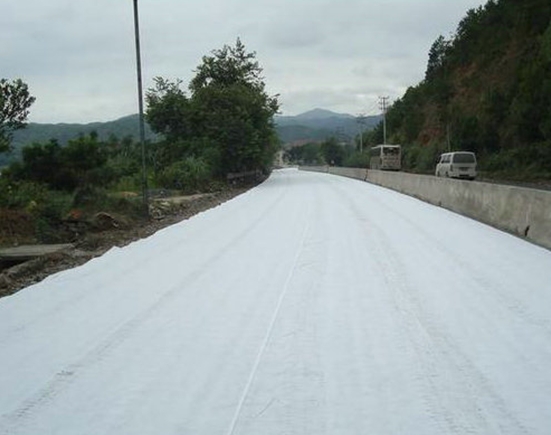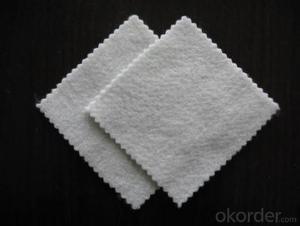Short fiber Nonwoven Geotextile for Geotechnical Engineering
- Loading Port:
- Qingdao
- Payment Terms:
- TT OR LC
- Min Order Qty:
- 20000 m²
- Supply Capability:
- 1500000 m²/month
OKorder Service Pledge
OKorder Financial Service
You Might Also Like
Functions of Non-woven Geotextile for Geotechnical Engineering:
1.Separation
The isolation of the railway dregs and the roadbed, roadbed and the soft base, surface of the airdrome and parking lot and the groundsill, different dam materials. It isolates the soil and the gravel of two kinds different.granule pathway from the groundsill or other buildings.
2.Reinforcement
The highway, railway, soil-stone dam, breakwater, airport, backfill soil of retaining wall, slope protection, etc in which distributes the earth stress, prevents the side-displacement of the earth body and improves the earthbody stability.
3.Protection
It prevents the bank from being washed out, protects the bank and the bottom, prevents the water and soil from being washed away
Technical Data Sheet of Short fiber Nonwoven Geotextile for Geotechnical Engineering:
Item | Art No. | 1 | 2 | 3 | 4 | 5 | 6 | 7 | 8 | 9 | 10 | 11 |
Unit weight, g/m2 | 100 | 150 | 200 | 250 | 300 | 350 | 400 | 450 | 500 | 600 | 800 | |
Weight tolerance, % | -8 | -8 | -8 | -8 | -7 | -7 | -7 | -7 | -6 | -6 | -6 | |
Thickness, ≥mm | 0.9 | 1.3 | 1.7 | 2.1 | 2.4 | 2.7 | 3.0 | 3.3 | 3.6 | 4.1 | 5.0 | |
Break strength, ≥kN/m | 2.5 | 4.5 | 6.5 | 8.0 | 9.5 | 11.0 | 12.5 | 14.0 | 16.0 | 19.0 | 25.0 | |
CBR burst strength, ≥kN | 0.3 | 0.6 | 0.9 | 1.2 | 1.5 | 1.8 | 2.1 | 2.4 | 2.7 | 3.2 | 4.0 | |
Tear strength, ≥kN | 0.08 | 0.12 | 0.16 | 0.20 | 0.24 | 0.28 | 0.33 | 0.38 | 0.42 | 0.46 | 0.60 | |
Width tolerance, % | -0.5 | |||||||||||
Break elongation, % | 25-100 | |||||||||||
EOS O90, mm | 0.07-0.2 | |||||||||||
Vertical permeability coefficient, cm/s | K×(10-1-10-3)K=1.0-9.9 | |||||||||||

- Q:How do geotextiles affect soil compaction?
- Geotextiles can help reduce soil compaction by providing a barrier between the soil and external forces. They distribute the load evenly, preventing the soil particles from being compressed too much. This allows the soil to maintain its natural structure and porosity, resulting in improved drainage and increased resistance to compaction.
- Q:Are geotextiles resistant to biological clogging?
- Yes, geotextiles are generally resistant to biological clogging. They are designed to allow water to pass through while preventing the movement of soil particles. This characteristic helps to minimize the growth of organisms, such as bacteria and algae, that can cause clogging. However, it's important to note that the level of resistance may vary depending on the specific type and quality of geotextile used.
- Q:What are the different geotextile installation guidelines?
- The different geotextile installation guidelines include proper site preparation, ensuring the soil is smooth and free of debris, anchoring the geotextile securely to prevent movement, overlapping the geotextile to ensure complete coverage, and using appropriate techniques for joining and sealing the geotextile. Additionally, it is crucial to follow manufacturer instructions and consult with an engineer for specific project requirements.
- Q:Do geotextiles affect soil pH levels?
- No, geotextiles do not affect soil pH levels.
- Q:What are the key considerations for geotextile installation in corrosive environments?
- The key considerations for geotextile installation in corrosive environments include selecting a geotextile material that is resistant to corrosion, ensuring proper anchoring and fastening methods to prevent movement or damage, conducting regular inspections and maintenance to identify any signs of corrosion, and implementing appropriate protective measures such as using a geotextile with a higher corrosion resistance rating or adding a barrier layer to minimize exposure to corrosive agents.
- Q:What are the key considerations for geotextile installation in seismic zones?
- Some key considerations for geotextile installation in seismic zones include the selection of a high-quality and durable geotextile material, ensuring proper anchoring and securing of the geotextile to prevent displacement during seismic events, and considering the potential for liquefaction or soil settlement in the design and installation process. Additionally, it is important to assess the potential for ground shaking and ground displacement in the seismic zone to determine the appropriate geotextile specifications and installation techniques.
- Q:Can geotextiles be used in coastal erosion control?
- Yes, geotextiles can be used in coastal erosion control. They are commonly used to stabilize slopes, reinforce soil, and protect shorelines from erosion caused by waves and currents. Geotextiles can help to reduce the impact of wave energy, trap sediment, and promote vegetation growth, ultimately helping to prevent coastal erosion.
- Q:What are the different geotextile durability testing standards?
- There are several geotextile durability testing standards, including the ASTM D4355-17 for durability of geotextiles by accelerated weathering exposure, ASTM D4751-10 for determining the apparent opening size of a geotextile, ASTM D6768-18 for evaluating the effects of heat on geotextiles, and ISO 10319:2015 for determining the resistance of geotextiles to weathering.
- Q:Are geotextiles resistant to hydrolysis?
- Yes, geotextiles are generally resistant to hydrolysis.
- Q:Who knows geotextile, how to sew, the best video
- Where do you use it? Professional production geotextile manufacturers to answer,
1. Manufacturer Overview |
|
|---|---|
| Location | |
| Year Established | |
| Annual Output Value | |
| Main Markets | |
| Company Certifications | |
2. Manufacturer Certificates |
|
|---|---|
| a) Certification Name | |
| Range | |
| Reference | |
| Validity Period | |
3. Manufacturer Capability |
|
|---|---|
| a)Trade Capacity | |
| Nearest Port | |
| Export Percentage | |
| No.of Employees in Trade Department | |
| Language Spoken: | |
| b)Factory Information | |
| Factory Size: | |
| No. of Production Lines | |
| Contract Manufacturing | |
| Product Price Range | |
Send your message to us
Short fiber Nonwoven Geotextile for Geotechnical Engineering
- Loading Port:
- Qingdao
- Payment Terms:
- TT OR LC
- Min Order Qty:
- 20000 m²
- Supply Capability:
- 1500000 m²/month
OKorder Service Pledge
OKorder Financial Service
Similar products
New products
Hot products
Related keywords
































